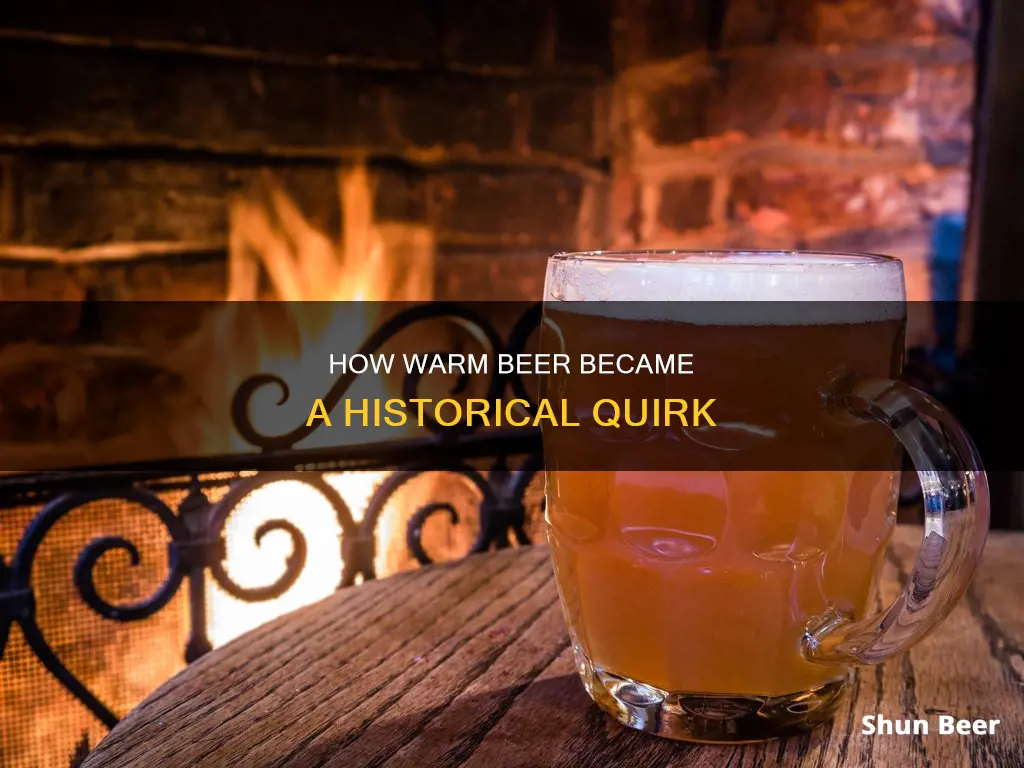
Drinking warm beer may seem like an unusual concept to those who associate the beverage with ice-cold temperatures, but it was once the norm. For centuries, people drank beer at ambient temperatures, and for a period of time, hot beer was all the rage. From the 1600s to the 1800s, mulled or heated beer was popular in taverns, with drinkers convinced of its health benefits. The belief that cold beer disrupted the master-qualities of heat and dryness in the stomach further reinforced the preference for warm beer. While the advent of refrigeration and the bottlecap played a role in the shift towards colder beer, cultural factors also influenced serving temperatures, with certain beers and regions still favouring warmer servings.
| Characteristics | Values |
|---|---|
| Time period | Before the 19th century |
| Beer temperature | Ambient, cellared, or heated |
| Beer type | Dark beers, stouts, and ales |
| Region | Central Europe, England |
| Reasons | Lack of refrigeration, preference, health benefits, flavour |
What You'll Learn

Beer was historically served warm
Called "mulled", this heated beer was the fashion of the day from 1500 to the early 1800s. It was considered to aid healthy living and improve digestion. The belief that the stomach was ruled by two "master-qualities" of heat and dryness meant that drinking cold beer was thought to upset digestion.
In the days before refrigeration, beer was commonly served at cellar temperatures. During summer, both cellar and serving temperatures rose, and in the winter, warm beer was welcomed for its pleasant and comforting qualities. Heating beer was also considered necessary due to the dominance of homebrew, as the use of substandard ingredients, combined with questionable brewing equipment and techniques, made most homemade beer unpalatable.
The transition from warm to cold beer can be attributed to two factors: the advent of refrigeration, and the invention of the modern bottlecap. Refrigeration made it easier and cheaper to keep beer cold, and the bottlecap meant beer could be shipped and served carbonated, which affected its taste and character.
Non-Alcoholic Beer: Friend or Foe for Fatty Liver?
You may want to see also

The advent of refrigeration
In ancient times, refrigeration was achieved through the use of ice pits and ice houses. In Ancient China and Mesopotamia, ice pits and ice houses were used for refrigeration. Persian ice houses, made of mud bricks, could be up to 20 meters high and had deep pits that held ice. In the Greco-Roman context, ice and snow were used to cool drinks, rather than preserve foodstuffs. The Roman bureaucrat Pliny the Younger once wrote to a gentleman who failed to show up to dinner, informing him that he would be charged for the pricey snow that had been ordered specifically for him.
The first instances of refrigeration were only available to the wealthy. Ice houses were often attached to castles, palaces, monasteries, and abbeys. It was necessary to have servants who could cut slabs of ice from nearby shallow water on freezing mornings and carry it back for storage in an ice house.
The genuine breakthrough in refrigeration came in the late 19th century with the invention of mechanical refrigeration. In 1873, Carl von Linde, working for the Spaten Brewery in Munich, invented a system of mechanical refrigeration. Using ether as a refrigerant, he was able to make block ice to cool the brewery's cellars. Although this process was expensive, by the 1880s, most breweries were making their own ice mechanically. This allowed for year-round brewing and the expanded availability of colder-processed lager beers. Breweries could be larger and no longer needed to be located near natural ice sources. The invention of mechanical refrigeration was a critical factor in the spread and later dominance of lager brewing throughout the world.
Beer and Painkillers: Mixing Tylenol and Alcohol
You may want to see also

Beer is still sometimes served warm
The preference for drinking beer warm continued until the 19th century, when the introduction of lager beer and the advent of artificial refrigeration made ice-cold beer more accessible. However, the tradition of drinking warm beer has not completely disappeared. Even today, in Central Europe, beer drinkers sometimes use a "bierwärmer", a narrow metal tube with a hanger, to bring their beers to a warmer temperature. Beer warmers were once a common sight in Czech pubs, and older customers in particular may still request a beer warmer to adjust their beer to their preferred temperature.
In addition, some beer styles are still commonly served at warmer temperatures than typical lagers or pilsners. Real ales, for example, are served at room temperature and should never be chilled. Drinking real ales slightly chilled is said to enhance their flavour, as "ice-cold beer numbs your taste buds". Similarly, stouts like Guinness are often served at warmer temperatures than lagers, and some varieties are even marketed as "extra chilled".
The preference for drinking beer at colder temperatures may also be influenced by the carbonation levels in the beer. Carbon dioxide is more soluble in cold water than warm water, so the warmer the beer is, the faster it goes flat. Therefore, highly carbonated beers may be better suited to being served cold, while low-carbonation beers like real ales are more suited to being served at warmer temperatures.
Botox and Beer: What's Safe and What's Not?
You may want to see also

Central Europeans use a Bierwärmer to warm beer
For centuries, people drank warm beer. From 1500 to the early 1800s, "mulled" or heated beer was the fashion of the day. People believed that drinking warm beer was good for their health. Several sources from the 17th century praised the virtues of warm beer, explaining that it was nourishing and good for the stomach.
While it is a myth that modern-day Europeans drink warm beer, they do prefer it at cellar temperature, which is a little colder than room temperature. This preference is based on the belief that any drink of quality, whether wine or beer, should be served at room temperature to appreciate its full flavour.
In Central Europe, beer drinkers sometimes use a device called a "bierwärmer" to bring their beers to the optimal temperature. Called a "bierwärmer" in German, and "ohříváček" in Czech, it is a narrow metal tube with a hanger and a lid. The container is filled with hot water, closed with the lid, and then hung in the glass. The hanger goes on the glass rim, and the ohříváček is dipped into the beer. The drinker can then warm the beer to their preferred temperature.
While the use of the bierwärmer has declined in recent years, it is still requested by some older customers in Central European pubs, harkening back to the region's more traditional serving temperatures.
Beer and Naproxen: A Dangerous Allergic Reaction Cocktail?
You may want to see also

Beer drinkers' preference for temperature
Beer drinkers' preferences for temperature have changed over time. From the perspective of the 20th century, it is hard to imagine that people drank warm beer, but for the majority of beer's history, refrigeration was not an option, and beer was served at ambient temperature.
In the early days of beer drinking, from the dawn of civilization, beer was served at room temperature. Later, it was cellared and served cool, and for several centuries, it was served hot. From 1500 to the early 1800s, beer was typically mulled, meaning heated, and drinkers were convinced it was good for their health. There were several varieties of spiced, hot beer, such as Dr. Butler's Ale, which was considered to aid digestion and help with colds and coughs.
The preference for warm beer also had to do with the dominance of homebrewing at the time. The use of substandard ingredients, combined with questionable brewing equipment and techniques, made most homemade beer unpalatable. Adding spices and warming the beer made it more appealing, and if the sugars were scorched, they caramelized, adding a more gentle roundness to the flavour.
In the 19th century, the popularity of mulled beers began to fade with the introduction of lager beer and the advent of artificial refrigeration. Lager was brewed to be drunk cold, and refrigeration made its production possible anywhere, year-round. Beer drinkers in America enthusiastically embraced light, crisp, ice-cold lagers, and heated ales became 'old-fashioned'.
Today, beer drinkers' preferences for temperature vary depending on the type of beer and the region. In Central Europe, for example, beer is typically served colder than in the past, but still warmer than the North American preference for ice-cold beer. In the UK, real ale is served at room temperature, while lager is served cold. Some beer drinkers believe that ice-cold beer numbs the taste buds, and that drinking beer slightly chilled is the best way to enjoy the flavour.
Beer and High Liver Enzymes: Is It Safe to Drink?
You may want to see also
Frequently asked questions
Yes, historically people drank warm beer. From the beginning of beer drinking, beer was served at ambient temperature. Later, it was cellared to be barely cooled, and for several centuries, piping hot was the temperature of choice.
Before refrigeration, warm was the only way to drink beer. In the winter, a hot tankard of beer would have been a pleasant and comforting distraction from the cold. People also believed that drinking cold beer would upset digestion.
The transition from warm to cold beer began with the advent of refrigeration and the modern bottlecap, which are both products of industrialization.
Yes, people still drink warm beer. In Central Europe, beer drinkers use a device called a bierwärmer to bring their beers to the optimal temperature. In the UK, real ale is served at room temperature.







